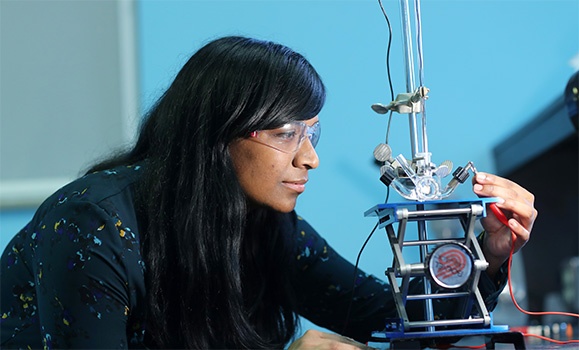Years ago when she was a PhD student, Mita Dasog used to visit elementary schools around Edmonton to talk to young girls about what it was like to be a scientist.
Although sheâd always felt supported in her own quest to become a scientist, it was clear from her experience doing outreach that other young girls were not always so lucky.
âI remember one of the girls asking me, âOh, I didnât realize women could be scientists,ââ says Dr. Dasog, now an assistant professor of Chemistry at Dal, recalling one visit to a class of sixth graders. âI was shocked. I had to take a step back and say, âWait a minute, we have a more fundamental problem where girls feel like they are not even capable of being in fields like this, let alone succeeding in them.â
Making an impact
Take one look at Dr. Dasogâs own young career so far and itâs clear just how misguided those perceptions are. She's had dozens of papers published in the field of nanomaterials and has already received several notable awards, including a Canadian Society for Chemistry National Award for Outstanding Graduate Work in Inorganic Chemistry, the Canadian Council of University Chemistry Chairsâ Doctoral Award for the top Canadian chemistry PhD in 2015, and a "Top 25" Global Young Scientists in Sustainable Research Award from the German government.
Last week, she added another honour to the list when she was named one of the top 150 Canadian women in STEM (science, technology, engineering, and math) by , a group aimed at encouraging more young women to pursue science-related careers. Earlier this year, Computer Science faculty member Rita Orji also made the list.
Dr. Dasog, who joined Dal in 2016 fresh off a postdoctoral fellowship at the California Institute of Technology (CalTech), focuses her research on creating materials that can be used in clean-technology applications.
For instance, she works to develop materials to convert sunlight into chemical fuels â a type of artificial photosynthesis that could one day help enable the carbon-neutral production of fuels for heavy-duty vehicles such as ships and aircraft.Â
She says being included on a list alongside the likes of Julia Levy, a biomedical scientist, entrepreneur and Order of Canada recipient, as well as noted science advocate Katie Gibbs, came as quite a surprise.
âIt is definitely very humbling to be listed alongside people who are doing such great work and having such an impact on society,â she says.
Discovering science
Dr. Dasog traces the deepening of her own interest in science back to when she was a teenager living in India. Although born in Saskatoon, her parents decided to move back to their home country when she was quite young. It was in high school there that she met a female biology teacher who inspired her to nurture her love of science.
At 16, she moved back to Canada and eventually began studying science at university, where she quickly developed an interest in materials chemistry and began working in labs. It was later when she started going to conferences as a PhD student that she really came to realize the extent of just how male-dominated the field of chemistry still was.
Seeking new inspiration, she found it in Jillian Buriak and Juli Gibbs â two researchers at University of Alberta.
Dr. Dasog says Dal has been a great fit for her as she begins to accelerate her career. She praises the universityâs robust culture of collaboration (a must in the world of clean-energy materials research) and the excellent gender ratio in her department (among the top five in the country, she says).
âItâs very comfortable to be in a community where people work really well together and thereâs not a lot of biases based on your gender or colour,â she says. âThe main emphasis is to do good science and encourage the next generation.â

